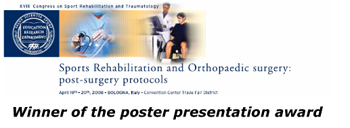| articolo-classificaz-eng.pdf | |
| File Size: | 346 kb |
| File Type: | |
Pellis G., Di Cosmo F.:
Classification of exercises for the rehabilitation of the knee
according to the theory of roto-translational and transla-rotational
XVII International Congress of Traumatology and Rehabilitaion - Bologna 2009
Introduction: The knee is the joint that combines an initial rotation (25-30 degrees) with a sliding motion which becomes more and more progressive. This roto-translational theory, has been joined by a more recent that initially provides a front sliding of the femur on the tibia of about 8 - 9 mm (for aa arc of 20-25 degrees), which is followed by a rotation phase. We define this theory transla-rotational.
The purpose of the study - Understand which are the exercises most recommended for proper rehabilitation of the knee, on the basis of the mechanical stresses produced by the motion that any single theory proposes:
The purpose of the study - Understand which are the exercises most recommended for proper rehabilitation of the knee, on the basis of the mechanical stresses produced by the motion that any single theory proposes:
|
in the rotation the points of contact between the surfaces follow one another so that at every point of contact on a surface it corresponds a different one over the other. In rolling there is not friction and usury of surfaces
|
in translation to a point of contact on a surface correspond more points of contact on the other. This causes friction and usury between the parts. The higher is the load transmitted, the more intense will be the deterioration factor between the parties
|
The theories
|
The roto-translation provides that the articular heads roll for the first 30 degrees and then begin in an ever more important way the sliding.
|
The transla rotation provides that the articular heads frontly slip for 8-9 cm (about 25-30 degrees) and then roll to the end of flexion.
|
The bibliographic and patent analysis
|
The roto-translational theory: we can be note that the scientific works temporally precede by far the date of the invention patent
Patent n. WO 97/38759 - 1997 - Draganich L.F., Andriacchi T. P., Andersson G. B (1987) Interaction between intrinsic knee mechanics and the knee extensor mechanism, J. Orthop. Res. 5:539-547; - Fleischmann J, Line R (1981) Human anatomy applied to physical education and sport, vol.1, S.S.S., Roma, 303; - Fumagalli Z, Fusaroli P, Lambertini G, Nesci E, Pasqualino A (1977) Human anatomy, vol.1, Piccin ed., Padova, vol. 1, pp 191-195; - Insall J.N. (1986) Knee Surgery Verduci editore, pp. 11, 12-13, 25; - Kapandji I A (1977)Articular physiology, Marrapese Ed. Demi s.r.l., Roma, 90; - Marinozzi G, Pappalardo S (1977) The knee joint, morphological and functional problems, Alcmeone, Istituto Superiore di Educazione Fisica, Roma, n.1, pp 25-30; - Melegatti G. (1997) Biomechanics of anterior cruciate ligament, Alea Ed., Milano, vol.2, 22-24; - Nissell R (1985) Mechanics of the knee, Acta Ortop. Scand. 56 (supp.216): 5-41; - Smidt G.L. (1973) Biomechanical analysis of knee flexion and extension, J. Biomech., 6:79-92; - Steinbrück K, (1997) Rehabilitation des Kniegelenkes nach Kreuzband - Operationen, Orthopädie-Technik, 725-735; - Tittel K (1979) Functional anatomy of man, Edi Ermes, Milano, 272; - Yamaguchi G.T., Zajac F.E. (1989) A planar model of the knee joint to characterize the knee-extensor mechanism, J. Biomech.,22:1-10. |
The transla-rotational theory: we can see that the scientific works are due at the date of the invention patent
Patent n. EP 0 361 405 A , 1990 patent n. WO 92 15264 A , 1992 - Putz, 1995; - Loudon et al, 1998. |
Studies of comparing between models - From a study on the comparison between the radiograms of a knee-type with the mechanical devices that reproduce the two motions considered, complete with monoplane models that reproduce the articular heads of the knee,we found that:
|
The model that proposes the roto-translational motion is always in a very similar position to those of the radiological profile.
|
The model that proposes the transla-rotational motion, at the end of flexion, is
located in a greatly advanced position and raised with respect to radiological profile |
Rehabilitation exercises - should be proposed so that we can achieve the restoration of full flexion-extension function and tolerance of the load of the knee without
that this can cause harmful stress to the articulation.
From the analysis of the mechanical stresses that arise in the translational and rotational motion, the exercises to propose in rehabilitation of the knee can be classified according to the hierarchies of intervention of each motion, as "recommended" and "not recommended".
The recommended exercises are those in which take place the rolling between the articular heads,
motion which excludes the usury determined by the translation
motion which excludes the usury determined by the translation
Conclusioni - Nella considerazione che l’evoluzione biologica ha sempre sposato i concetti di rendimento e salvaguardia, difficilmente si può pensare che attività particolarmente utili all’uomo quali la deambulazione e la corsa possano provocare sfregamento ed usura all’interno di un articolazione fondamentale per la vita di relazione e l’esistenza stessa dell’uomo, come quella del ginocchio.
Ciò porta a pensare che la teoria roto-traslatoria sia quella più accreditabile al moto del ginocchio e che le esercitazioni principali sulle quali basare un protocollo riabilitativo, sono quelle eseguite ad angoli aperti fino ai 30°, che, sfruttando il solo moto rotatorio, evitano le sollecitazioni meccaniche che producono USURA, compromettendo il corretto utilizzo dell’articolazione.
Ciò porta a pensare che la teoria roto-traslatoria sia quella più accreditabile al moto del ginocchio e che le esercitazioni principali sulle quali basare un protocollo riabilitativo, sono quelle eseguite ad angoli aperti fino ai 30°, che, sfruttando il solo moto rotatorio, evitano le sollecitazioni meccaniche che producono USURA, compromettendo il corretto utilizzo dell’articolazione.






